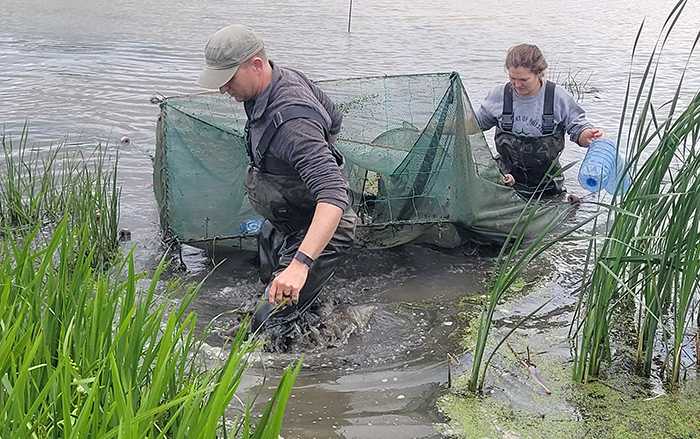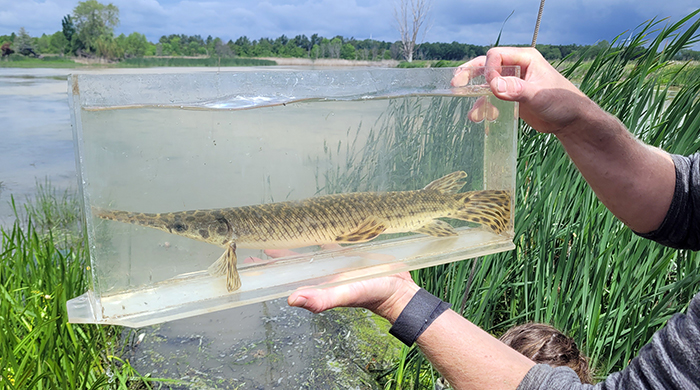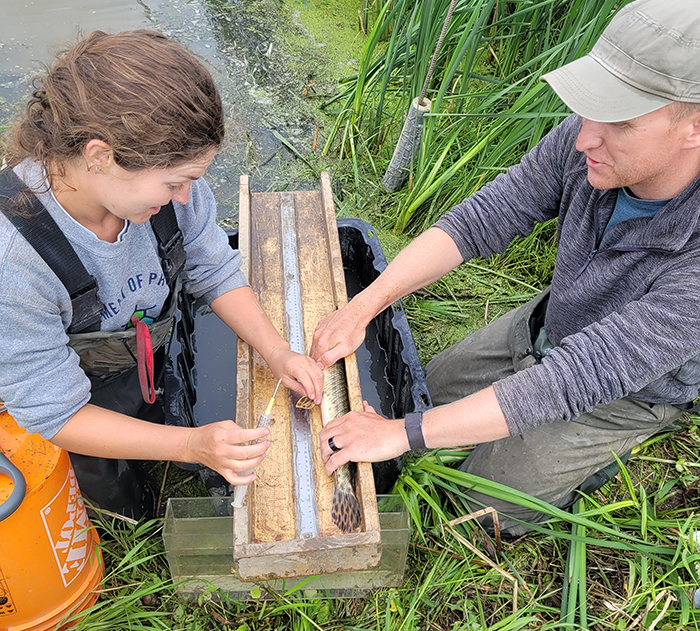
Student, biologist charting nature at work near Rondeau
As a cool wind and spitting rain whips across the marshlands near Rondeau Park, a PhD student and a biologist are slogging waist-deep through a combination of water, muck and weeds.
For Dominique Rumball and Craig Paterson, there is no place else they’d rather be.
Dominique is a PhD student with the Department of Physical and Environmental Sciences at the University of Toronto Scarborough while Craig is the manager of biology at the St. Clair Region Conservation Authority.
The two are in the third year of an in-depth habitat assessment at the Keith McLean Conservation Lands, a 130-hectare property donated to the St. Clair Region Conservation Foundation by McLean, an ardent conservationist who died in 2012 at the age of 90.
The property, located just east of Rondeau Provincial Park, includes farmland, forests, ponds, wetlands, and prairie. The property is open to the public and features four kilometres of trails. It is visited by thousands of hikers and birders each year.
A significant part of the work includes restoration of the spawning areas used by the Spotted Gar; a fish listed as endangered under the Species at Risk Act.
Rumboll said the species only exists in three areas in Canada, Long Point Bay, Point Pelee, and Rondeau Bay. The estimated local population of the gar, known for its distinctive long beak-like mouth, is just over 8,000.
Rumboll said it was discovered that common carp pose a serious threat to gar spawning as the bottom-feeding carp root up areas where eggs are laid. The plan is to install barriers to keep the largest carp out of the area.

In order to monitor the health and numbers of aquatic species in ponds and a culvert on the property, nets are placed to capture samples.
Known as fyke nets, they use “wings” to guide fish along the outside of the nets and funnel them inside where a series of chambers and baffles make it difficult for the fish to escape.
Every 24 hours the nets are pulled and data is entered regarding the size and species of fish and minnows caught. Spotted Gar are tagged using a PIT (Passive Integrated Transponder) system.
Gar have bone-like scales which aid in protecting them from predators, but make them challenging to tag. Rumboll uses a hypodermic needle placed carefully behind a fin to attach the tag.
Rumboll said the tags (under 1cm long and only 1-2mm in diameter) “allow us to identify a fish, if we have captured it before and where, and can also give us some insight towards where the gar move/spend time, and over time if they are growing/surviving.”
One hundred fish have been tagged this year, compared with 60 in 2023. In addition to gar, sunfish, crappie, warmouth, bowfin and various species of catfish have been netted.
Spotted Gar live up to eight years and can reach a length of 50 to 75 centimetres.

Although gar monitoring is a significant portion of the work, the main objective of the project is to conduct an in-depth habitat assessment of the area, including water quality and temperature (also measured daily) vegetation and control of invasive species including phragmites, a long reed-like plant that grows in wetlands whose dense nature crowds out native plants and damages wildlife habitat.
“We are in the process of conducting a before and after control impact study,” Rumboll said. We are studying sites that have been controlled and impacted by humans along with the 27 hectares of the wetland which was restored by the Conservation Authority in 2007.”
Paterson said “coastal wetlands are one of the rarest wetlands areas we have left. We need to reclaim and restore it where we can and develop best management practices with the agricultural sector because we need both sectors to thrive. I am absolutely convinced we can achieve that balance.”
He said there has been an increased awareness in recent years of how critical coastal wetlands are to the health of the Great Lakes.
“Wetlands are critical to help in areas such as water temperature, flooding control and overall health of the ecosystem,” he said. “Wetlands can actually help adjacent agricultural land become more productive.”
He said programs designed to allow conservation authorities and private landowners to collaborate are beneficial to every stakeholder.
“If we can combine our knowledge, we can help landowners develop practices and we can unlock funding which will make efforts more economical and beneficial for everyone.”
Rumboll is in the first year of her five-year PhD program through the Mandrak Lab supervised by Nicholas Mandrak and Scott Reid, and hopes to be able to continue her work which takes place each May and June.
“We have a unique opportunity to examine this area, much of which was cleared and drained for farming in the 1950s, to determine what effects that has had, to see how the restoration work is proceeding and learn so much,” she said.
Funding for the program has been provided provincially by the Ministry of the Natural Resources and Forestry ($75,000) and federally through fisheries and Oceans Canada under the Canadian Nature Fund for Aquatic Specias at Risk ($136,580). Paterson is seconded to the project for one month each year.
While it takes time, in some ways nature is already returning the restored area to what it once was.
“We have great jobs,” Paterson said. “If people could see what we see on a daily basis, they would recognize the value of this work and the incredible ability of nature to take care of us if we give it a chance.”






